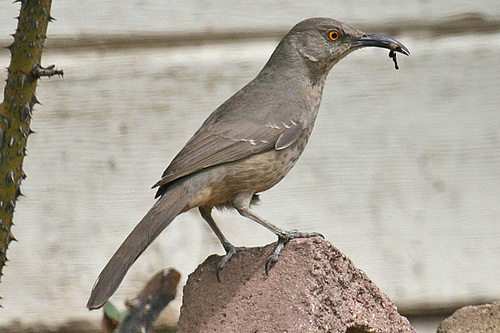
Curve-billed Thrasher
The Curve-billed Thrasher (*Toxostoma curvirostre*) is a medium-sized songbird native to the southwestern United States and Mexico. It is known for its distinctive, long, curved bill, which it uses to forage for insects and other invertebrates in the soil. This adaptable bird thrives in a variety of arid and semi-arid habitats, playing an important role in seed dispersal and insect control. While not globally threatened, it faces regional challenges due to habitat loss and degradation. The Curve-billed thrasher is also culturally significant in some regions, with its melodic song often featured in folklore.
24-29 cm
Length
30-34 cm
Wingspan
Least Concern
Conservation Status
Distribution
The Curve-billed Thrasher is primarily found in the southwestern United States (Arizona, New Mexico, Texas, and parts of Colorado, Oklahoma, and California) and throughout much of Mexico. It does not typically undertake long-distance migrations, though some populations may move shorter distances in response to food availability or weather.
Lifespan
Typically 3-5 years in the wild, though some individuals may live longer.
Curve-billed Thrasher's Habitat
Habitat Types
Desert scrub, Chaparral, Arid grasslands, Suburban gardens (in some areas)
Climate Zones
Arid, Semi-arid, Subtropical
Adaptations
Their curved bill is a key adaptation for digging and probing in the soil. They are also well-suited to hot, dry climates, obtaining much of their water from their food.
Variations
Several subspecies are recognized, differing slightly in plumage coloration and size. For example, *T. c. curvirostre* is found in eastern and central Mexico, while *T. c. oberholseri* occurs in southern Texas and northeastern Mexico.
Appearance
Breeding Plumage
Plumage remains relatively consistent throughout the year.
Seasonal Feather Changes
No Significant seasonal variation.
Sex Based Plumage Differences
Males and females have similar plumage.
Notable Features
Long, decurved bill, Grayish-brown overall plumage, Pale spotting on the breast, Yellow or orange eyes
Diet and Feeding
Primary Foods
Insects, Spiders, Other invertebrates, Fruits, Seeds
Foraging Behavior
Forages primarily on the ground, using its curved bill to probe and dig in the soil, leaf litter, and under rocks. It may also glean insects from vegetation.
Specializations
The curved bill is highly specialized for extracting prey from crevices and the ground.
Seasonal Diet Variations
Diet may shift slightly depending on the availability of food resources. For example, they may consume more fruits during certain seasons.
Behavior
Social Structure
Generally solitary or found in pairs, especially during the breeding season. May form small, loose flocks outside of the breeding season.
Communication
Variety of calls, including a sharp 'whit-wheet', Complex and melodious song, often delivered from an exposed perch, Males often sing to defend territory and attract a mate
Migration
Mostly resident (non-migratory), although some populations may make short-distance movements.
Territorial or Group Behaviors
Territorial during the breeding season, defending nesting and foraging areas. Males sing to advertise territory boundaries.
Conservation
Threats
Habitat loss and degradation due to urbanization and agriculture, Pesticide use, which can reduce insect prey populations, Increased frequency of drought due to climate change
Protection Programs
Habitat restoration projects in some areas, Conservation efforts focused on maintaining native vegetation
Local National Laws
Protected under the Migratory Bird Treaty Act in the United States.
Population Trend
Stable
Population Estimates
Not Evaluated
Interesting Facts
They are known for their inquisitive nature.
Curve-billed Thrashers often approach humans and investigate their surroundings.
They can mimic the calls of other birds.
Although not as accomplished mimics as some other Mimids, they incorporate elements of other birds' songs into their repertoire.
They often reuse nests from previous years.
This behavior saves time and energy during the breeding season.
The oldest recorded Curve-billed Thrasher was at least 7 years, 11 months old.
It was banded in Arizona in 1959 and found in 1967.
Faqs about Curve-billed Thrasher
What do Curve-billed Thrashers eat?
They eat a variety of insects, spiders, fruits, and seeds, using their curved bill to forage on the ground.
Where do Curve-billed Thrashers live?
They live in arid and semi-arid regions of the southwestern United States and Mexico, inhabiting desert scrub, chaparral, and grasslands.
Are Curve-billed Thrashers endangered?
No, they are classified as 'Least Concern' by the IUCN, but they do face threats from habitat loss.
Do Curve-billed Thrashers migrate?
They are mostly resident (non-migratory), but some populations may move short distances.
Copyright @ Nature Style Limited. All Rights Reserved.
 English
English